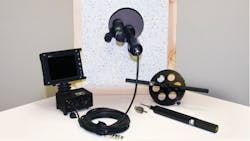What can you do if breaching isn't an option and more intelligence is necessary to make the call? It's potentially a hostage situation. Doors are barricaded. Windows are blocked. Every attempt at establishing communication has failed; no one's talking and you can't see in ... yet. The wrong decision can transform the scene into nightmare quick. Time to think outside the box - or rather, inside.
At their core, there are three different methods on gaining intelligence while remaining covert: emit a signal to digitally map the space; silently make a penetration; or use an existing access point. Unfortunately we all can't win the lottery and have a nice heating duct to snake in a fiberscope every time. With this, we're left with two options to figure out where people are. In effect, we have two ways to see through a wall. The self-referencial through-the-wall technology concept allows law enforcement and SWAT tactical teams to gather intelligence on what's on the other side of the wall and remain covert while doing so. One solution utilizing a type of signal. Another quietly installs a small camera - 'small' as in an 1/8 of an inch (roughly the width of my No. 2 pencil).
Intelligence
Two typical ideas come to mind when someone needs to 'see' what they cannot. One locating aircraft with radar, the other a bat with sound or echo-location. (Not Batman, we'll get to the Dark Knight later.) Both signals have been utilized to allow officers to see through a wall. Moreover, see where something is when it moves. Unfortunately the feasibility of utilizing a sound- or sonar-based technology may have presented more troubles than initially let-on. And it is possible development hasn't resolved these issues as of yet. A report sponsored by Department of Justice Office of Justice programs - National Institute of Justice written by Ivan Cowie of the Time Domain Corp., "Through-Wall Surveillance for Locating Individuals Within Buildings: Final Scientific and Technical Report," explains that "a speaker-based sonar will reflect so much energy off of the wall that the display will have to be remote to mitigate false alarms from the operator's movements."
Radar has less of a reflection if it's held away from the 'target' wall. While it would be optimal for radar devices to be held against a hard surface, it will still be able to provide useable data the device does require to remain still. To be useful in a law enforcement or military setting, unlike the massive traditional aircraft-detecting systems, this radar use should be handheld and, in through-the-wall purposes, should offer more than the bleeps, the sweeps, and the creeps.
With applications in military, law enforcement and search and rescue radar through-the-wall technology can detect movement and presence of life - being able to 'see' such subtle movements as minute as normal human breathing. With more dimensions being analyzed, more data is displayed. Likewise, the more data, the larger the handheld.
Camero-Tech began development in through-wall technology to provide a life-saving solution. In one situation, one of their products were used to recover a kidnapped victim. It identified three people: two in constant motion, one static. The operators breached and successfully rescued the hostage once they observed two in motion leaving the room. "The systems are based on radar technology, specifically ultra-wideband (UWB) radar," says Josh Levontin, Director of Business Development at Camero-Tech. "A range of electromagnetic signals penetrate the wall and return back to the system."
Handheld radar units like the Range-R from CyTerra Division of L-3 Communications Security and Detection Systems and Camero-Tech's Xaver 100 offer basic distance information. With a range of up to 65 feet (20 meters) for the Xaver products and up to 50 feet with the Range-R, all devices inform the user distance and movement of the occupied persons in a room.
"Radar is just a tool for intel gathering just like any other tool," says Lt. Buzz Benson of the Gwinnett County (Ga.) Sheriffs Office. "For example, if we're going to push a camera into the kitchen then we'll use the radar to make sure we don't have ... any movement in the kitchen at that time."
"Typically speaking the radar allows you instant information as to what's going on on the other side of that wall within the range of the radar ... but you can move radar around or you can leave it stationary - we do both," he says.
The Xaver 100 and Range-R are like Apple and Android, both will allow you to make a call - just with different user interfaces. The Xaver 100 shows a person's distance on an adjusting-scale display in two-meter intervals. The Range-R, however, provides more of a numerical reading, with a number shown. Targets are put into two categories, "movers" or "breathers," and displays an appropriate icon for each person detected. Camero-Tech has recently integrated range-detection technology into their Xaver airborne imaging drone (AID) - ultimately a 'through the roof' solution.
Now we know how far a person, moving or not, is away from us, how about position and placement in the room? Are they to the left, to the right? Are there static objects? The Xaver 400 provides this as well as a metered range from the wall. The device's interface is split into two with a grid overlayed for distance. One half plots movement in a top-down image of the room with unique icons for each detected object (alive or static). The second part provides a type of movement graph. As objects move closer a line adjusts accordingly, each reads with its own line.
SWAT teams around the country have used this two-dimensional information since 2009. Benson's team in Georgia has reportedly deployed the Xaver 400 in over 100 different operational urban missions such as warrant arrests, drug raids, hostage situations, building assaults and armed standoff situations.
Camero-Tech's Xaver 800 works much the same as their 400, but includes height detection. Using UWB sensors, the device analyzes data and produces, according to its brochure "room general layout, including dimensions and major infrastructure elements." Officers are presented with a 3-D image of the room as well as a similar top-down view from a previous model.
Apart from sound waves and radar, Massachusetts Institute of Technology (MIT) published a paper reporting the possibility of utilizing a Wi-Fi signal for human detection and tracking behind a wall - it tells of a successful experiment where a team tracked an iRobot Create robot. In the film "The Dark Knight," a system turned cellphones into a type of sonar. Returning signals created a 3-D digital map of the world, allowing characters to see through solid objects for planning and strategy. While this 3-D concept is Hollywood magic, the MIT team calls their version Wi-Vi (Wi-Fi Vision). The paper, "See Through Walls with Wi-Fi!" written by Fadel Adib and Dina Katabi, lists three areas where this technology can be utilized: gesture-based interfaces, infrared and thermal imaging, and through-wall radar. It explains an early attempt in using a Wi-Fi signal to see through a wall was done in 2012. However this required a transmitter and a receiver inside the room. This isn't practical when lives are on the line and the possibility to place a device inside is, well, not an option. The paper writes, "in contrast, Wi-Vi can perform through-wall imaging without access to any device on the other side of the wall."
Yet, more detail may be needed for further action - having the location of an object (be that human or non) might not be enough in some situations. In these cases eyes on target - a picture if you will - may be necessary. "It's all about what you see," says Bob Levine, president of Zistos. "The subtle details can mean the difference between life and death."
The key here though is how to silently get a lens inside. A number of years ago a law enforcement officer approached Zistos with this very same dilemma. His team put together an ad-hoc system, but it had its flaws. Familiar with putting together prototypes Levine charged the Zistos team with further development. Later Detective R. Ryan Perry of the Las Vegas Metro PD Technical and Surveillance Section added his insight to the new system as well.
Deceptively simplistic, the aptly-named Through-The-Wall Camera Kit's complexity comes from accomplishing its task in near silence. The system works from an 1/8-inch wide pin-hole low light video camera with a zoom lens. It requires a six-inch access space to where a mounting clamp attaches to the near wall. This acts in a dual purpose both to steady the drill and camera. An IR illuminator can be inserted in a second pin hole using the same space. The full system includes a WalkAbout III rugged high resolution LCD monitor, camera, cables, stud finder, hand drill, and specialized drill bit and jig and mount.
The company and Perry's team had passed kit modifications back and forth. Using one of these iterations, Las Vegas Metro SWAT and the Technical and Surveillance Section responded to a hostage barricade situation. As events unfolded, their through the wall kit allowed them to see the suicidal woman holding a butcher knife to an infant's throat.
With no clear view snipers were unable to take any kind of action. Taking position in an adjoining apartment sharing a wall with the living room. Using their kit, they saw her walking around the room, pacing back and forth in and out of the room threatening the baby. "It gave us the ability to give that information in real time to the SWAT commander back at the tactical operations center," explains Perry. About six hours in presented the first opportunity to make entry.
"As soon as she set the baby down on the bed, we knew that we had an opportunity to make entry without injuring her or the baby," says Perry. "That unit they had was the catalyst for them to go in and breach the wall. They would have never been able to do that without that view."
Be it radar data or video, each solution provides law enforcement the ability to capture the display and stream it to monitoring commanders nearby or in the mobile command center. From there departments can store the feed on a server and transmit it to more officers on scene enhancing situational awareness. With clever and creative officers, the options and possibilities are nearly endless with what your agency can do with the collected information.
While it may not be feasible for each entry to utilize all the technologies available to discover a person's location and then install a covert camera to have eyes inside there is potential that the use of one to benefit another. Each provides another uniquely innovative tool for law enforcement. Each provides one more layer of information; one more way for officers and the innocent to return to safety.

Jonathan Kozlowski
Jonathan Kozlowski was with Officer.com, Law Enforcement Technology, and Law Enforcement Product News from August 2006 to 2020.
As former Managing Editor for Officer Media Group, he brought a dedicated focus to the production of the print publications and management of the Officer.com online product and company directory. You can connect with Jonathan through LinkedIn.
Jonathan participated as a judge for the 2019 and 2020 FOLIO: Eddie & Ozzie Awards. In 2012, he received an APEX Award of Excellence in the Technology & Science Writing category for his article on unmanned aerial vehicles (UAVs) in police work, aptly titled "No Runway Needed".



